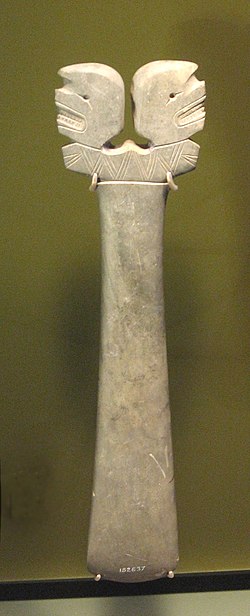Greenstone is a common generic term for valuable, green-hued minerals and metamorphosed igneous rocks and stones which early cultures used in the fashioning of hardstone carvings such as jewelry, statuettes, ritual tools, and various other artifacts. Greenstone artifacts may be made of greenschist, chlorastrolite, serpentine, omphacite, chrysoprase, olivine, nephrite, chloromelanite among other green-hued minerals.[1] The term also includes jade and jadeite, although these are perhaps more frequently identified by these latter terms.[2] The greenish hue of these rocks generally derives from the presence of minerals such as chlorite, hornblende, or epidote.[3]


Greenstone minerals were presumably selected for their color rather than their chemical composition. In archaeology therefore, having a loosely applied general term is at least partially influenced by the observation that ancient cultures often used and considered these various green-hued materials as interchangeable.[4] Greenstone objects are often found very considerable distances from the source of the rock, indicating early travel or trading networks. A polished jadeite axe head in the British Museum (4000-2000 BCE) was found in Canterbury, Kent but uses stone from the Alps of Northern Italy, and objects from other parts of the world had travelled comparable distances to their findspots.[5]
Ancient China and Mesoamerica have special reputations for the prevalence and significance of greenstone (particularly jade) usage. Greenstones also figure prominently in the indigenous cultures of southeastern Australia, and among the Māori of New Zealand (who knew greenstone as pounamu).[3] Neolithic Europe also used greenstone, especially for prestige versions of axe tools, not made for use; comparable jade versions of tools and weapons also appeared in the Olmec and other Pre-Columbian cultures and in early Chinese civilization.
Gallery of greenstone versions of tools or weapons
editSee also
editNotes
edit- ^ See "Glossary" in Hendon & Joyce (2004, p.327); also Kipfer (2000, pp.217–218).
- ^ Kipfer (2000, pp.217–218); Pool (2007, p.150)
- ^ a b Kipfer (2000, p.218)
- ^ Kipfer (2000, pp.217–218)
- ^ British Museum Archived 2012-10-26 at the Wayback Machine, "Axe" Acq. 1901,0206.1
External links
edit- H. D. Skinner, Otago University Museum (1936). "New Zealand Greenstone". Transactions and Proceedings of the Royal Society of New Zealand. 65: 211–220.
- F. J. Turner, Otago University (1936). "Geological Investigation of the Nephrites, Serpentines, and Related "Greenstones" used by the Maoris of Otago and South Canterbury". Transactions and Proceedings of the Royal Society of New Zealand. 65: 187–210.
References
edit- Hendon, Julia A.; Rosemary A. Joyce, eds. (2004). Mesoamerican Archaeology: Theory and Practice. Blackwell Studies in Global Archaeology. Oxford, UK and Malden, MA: Blackwell Publishing. ISBN 0-631-23051-3. OCLC 51536572.
- Kipfer, Barbara Ann (2000). "Greenstone". Encyclopedic Dictionary of Archaeology. New York: Kluwer Academic/Plenum Publishers. pp. 217–218. ISBN 0-306-46158-7. OCLC 42692203.
- Pool, Christopher A. (2007). Olmec Archaeology and Early Mesoamerica. Cambridge World Archaeology. Cambridge and New York: Cambridge University Press. ISBN 978-0-521-78882-3. OCLC 68965709.